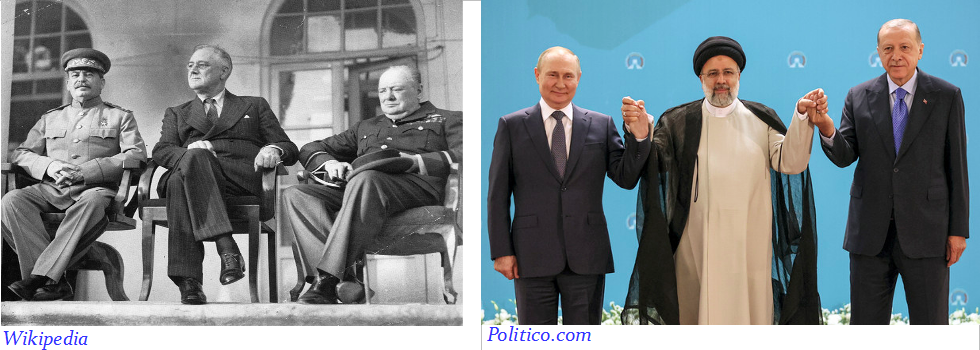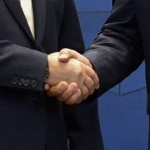The summit between Russian President Vladimir Putin, Iranian President Ebrahim Raisi and Turkish President Recep Tayyip Erdoğan that took place in Tehran on 19th July is reminiscent of the meeting that took place in the same venue in 1943 between British Prime Minister Winston Churchill, American President Franklin Delano Roosevelt and the Soviet Union’s leader Joseph Stalin. The similarities extend not only to the place but also to other circumstances. The nations represented by the three leaders of 1943 were in a state of war; the same applies to the three nations whose representatives gathered in Tehran of 2022. Seventy-nine years ago the United Kingdom, the United States and the Soviet Union were engaged in hostilities against Germany, and – in the case of the United States and partly the United Kingdom – against Japan.
Today Russia is in deep conflict with the collective West through the war by proxy in Ukraine, Iran has been a besieged state – i.e. suffering from a variety of Western sanctions – for more than forty years while Turkey – though formally the West’s ally and a member of NATO – is straddling the West-East political divide, increasingly flirting with Moscow, especially since the failed coup d’état carried out by (pro-)Western powers against Recep Erdoğan.
Yes, there are issues that threaten to break up the political unity formed between Ankara, Tehran and Moscow – with Syria and the Turkish provision of Bayraktar drones to Ukraine coming at the top of the list of divergences – yet, the factors that glue the alliance emerge equally powerful. Now wonder that at more or less the same time the American president visited Israel and Saudi Arabia, as if consolidating these three nations against the aforementioned triangle.
Russia with its over 140 million inhabitants, coupled with Turkey and Iran numbering a bit more than 80 million citizens each compare well with the 30 million of Saudi Arabians, 10 million Israelis and 330 Americans, so much so that the triangle Ankara-Tehran-Moscow is made up of countries that are geographically close to one another, which is not the case with their Washington-Tel Aviv-Riyadh counterpart alliance. Also ethnically, the former three are far more homogeneous, while American society is undergoing a huge ethnic replacement, which does not bode well for the national integrity.
True, the Washington-Tel Aviv-Riyadh axis has the backing of the European Union or the countries of G7, but then the Ankara-Tehran-Moscow axis can rely on the support coming from China: the world’s second largest economy, a nuclear power, the world’s technological hub, having a population exceeding one billion people. Also, Russia and Iran are members of the BRICS (Brasilia, Russia, Iran, China and South Africa) alliance, something that can counterpoise the G7 Group or the European Union.

The summit was organized as part of the series of talks on Syria. Moscow and Tehran hold views opposed to those of Ankara. President Recep Erdoğan wants to preserve the safety zone in northern Syria, controlled only by the Turkish troops, claiming that it is a place from where Kurdish terrorists infiltrate Turkish territory. This strip of land in northern Syria resembles the strip of land in eastern Ukraine – the Donbass region and the whole strip of land that can be traced along eastern and east-southern borders of Ukraine – that has been taken over by the Russian army.
The two political camps are likely to vie to curry favour with India due to the country’s geographical location, large population and developing economy.
Iran is a living example of a relatively small nation surviving under the duress of economic and political sanctions for almost half a century. Russia could have – if it only wanted – an autarchic economy. If Iran has survived four decades, why should Russia – a country far larger and blessed with all the resources – fall under the pressure from the West?




